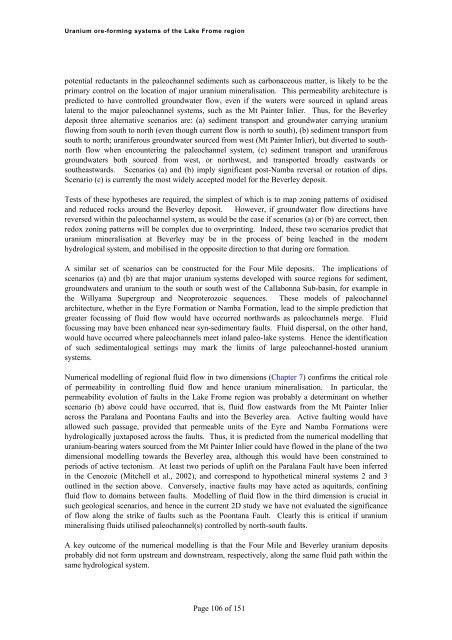Uranium ore-forming systems of the - Geoscience Australia
Uranium ore-forming systems of the - Geoscience Australia
Uranium ore-forming systems of the - Geoscience Australia
Create successful ePaper yourself
Turn your PDF publications into a flip-book with our unique Google optimized e-Paper software.
<strong>Uranium</strong> <strong>ore</strong>-<strong>forming</strong> <strong>systems</strong> <strong>of</strong> <strong>the</strong> Lake Frome regionpotential reductants in <strong>the</strong> paleochannel sediments such as carbonaceous matter, is likely to be <strong>the</strong>primary control on <strong>the</strong> location <strong>of</strong> major uranium mineralisation. This permeability architecture ispredicted to have controlled groundwater flow, even if <strong>the</strong> waters were sourced in upland areaslateral to <strong>the</strong> major paleochannel <strong>systems</strong>, such as <strong>the</strong> Mt Painter Inlier. Thus, for <strong>the</strong> Beverleydeposit three alternative scenarios are: (a) sediment transport and groundwater carrying uraniumflowing from south to north (even though current flow is north to south), (b) sediment transport fromsouth to north; uraniferous groundwater sourced from west (Mt Painter Inlier), but diverted to southnorthflow when encountering <strong>the</strong> paleochannel system, (c) sediment transport and uraniferousgroundwaters both sourced from west, or northwest, and transported broadly eastwards orsou<strong>the</strong>astwards. Scenarios (a) and (b) imply significant post-Namba reversal or rotation <strong>of</strong> dips.Scenario (c) is currently <strong>the</strong> most widely accepted model for <strong>the</strong> Beverley deposit.Tests <strong>of</strong> <strong>the</strong>se hypo<strong>the</strong>ses are required, <strong>the</strong> simplest <strong>of</strong> which is to map zoning patterns <strong>of</strong> oxidisedand reduced rocks around <strong>the</strong> Beverley deposit. However, if groundwater flow directions havereversed within <strong>the</strong> paleochannel system, as would be <strong>the</strong> case if scenarios (a) or (b) are correct, <strong>the</strong>nredox zoning patterns will be complex due to overprinting. Indeed, <strong>the</strong>se two scenarios predict thaturanium mineralisation at Beverley may be in <strong>the</strong> process <strong>of</strong> being leached in <strong>the</strong> modernhydrological system, and mobilised in <strong>the</strong> opposite direction to that during <strong>ore</strong> formation.A similar set <strong>of</strong> scenarios can be constructed for <strong>the</strong> Four Mile deposits. The implications <strong>of</strong>scenarios (a) and (b) are that major uranium <strong>systems</strong> developed with source regions for sediment,groundwaters and uranium to <strong>the</strong> south or south west <strong>of</strong> <strong>the</strong> Callabonna Sub-basin, for example in<strong>the</strong> Willyama Supergroup and Neoproterozoic sequences. These models <strong>of</strong> paleochannelarchitecture, whe<strong>the</strong>r in <strong>the</strong> Eyre Formation or Namba Formation, lead to <strong>the</strong> simple prediction thatgreater focussing <strong>of</strong> fluid flow would have occurred northwards as paleochannels merge. Fluidfocussing may have been enhanced near syn-sedimentary faults. Fluid dispersal, on <strong>the</strong> o<strong>the</strong>r hand,would have occurred where paleochannels meet inland paleo-lake <strong>systems</strong>. Hence <strong>the</strong> identification<strong>of</strong> such sedimentalogical settings may mark <strong>the</strong> limits <strong>of</strong> large paleochannel-hosted uranium<strong>systems</strong>.Numerical modelling <strong>of</strong> regional fluid flow in two dimensions (Chapter 7) confirms <strong>the</strong> critical role<strong>of</strong> permeability in controlling fluid flow and hence uranium mineralisation. In particular, <strong>the</strong>permeability evolution <strong>of</strong> faults in <strong>the</strong> Lake Frome region was probably a determinant on whe<strong>the</strong>rscenario (b) above could have occurred, that is, fluid flow eastwards from <strong>the</strong> Mt Painter Inlieracross <strong>the</strong> Paralana and Poontana Faults and into <strong>the</strong> Beverley area. Active faulting would haveallowed such passage, provided that permeable units <strong>of</strong> <strong>the</strong> Eyre and Namba Formations werehydrologically juxtaposed across <strong>the</strong> faults. Thus, it is predicted from <strong>the</strong> numerical modelling thaturanium-bearing waters sourced from <strong>the</strong> Mt Painter Inlier could have flowed in <strong>the</strong> plane <strong>of</strong> <strong>the</strong> twodimensional modelling towards <strong>the</strong> Beverley area, although this would have been constrained toperiods <strong>of</strong> active tectonism. At least two periods <strong>of</strong> uplift on <strong>the</strong> Paralana Fault have been inferredin <strong>the</strong> Cenozoic (Mitchell et al., 2002), and correspond to hypo<strong>the</strong>tical mineral <strong>systems</strong> 2 and 3outlined in <strong>the</strong> section above. Conversely, inactive faults may have acted as aquitards, confiningfluid flow to domains between faults. Modelling <strong>of</strong> fluid flow in <strong>the</strong> third dimension is crucial insuch geological scenarios, and hence in <strong>the</strong> current 2D study we have not evaluated <strong>the</strong> significance<strong>of</strong> flow along <strong>the</strong> strike <strong>of</strong> faults such as <strong>the</strong> Poontana Fault. Clearly this is critical if uraniummineralising fluids utilised paleochannel(s) controlled by north-south faults.A key outcome <strong>of</strong> <strong>the</strong> numerical modelling is that <strong>the</strong> Four Mile and Beverley uranium depositsprobably did not form upstream and downstream, respectively, along <strong>the</strong> same fluid path within <strong>the</strong>same hydrological system.Page 106 <strong>of</strong> 151
















